-
09/07/2021
Sexuality is associated with the quality of life of the elderly!
Revista Brasileira de Enfermagem. 2021;74:e20201272
Resumen
Sexuality is associated with the quality of life of the elderly!
Revista Brasileira de Enfermagem. 2021;74:e20201272
DOI 10.1590/0034-7167-2020-1272
Visualizações0Ver maisABSTRACT
Objective:
to analyze the association between sexuality and quality of life of Brazilian elderly residents in the community.
Methods:
a cross-sectional study conducted with 477 Brazilian elderly. The data were collected between August and October 2020. We used the EVASI and WHOQOL-OLD (World Health Organization Quality of Life). Data analysis was performed with Mann-Whitney, Spearman and Kruskal-Wallis correlation tests, with Bonferroni post-hoc application when necessary, considering a 95% confidence interval.
Results:
there was a statistical association between all dimensions of sexuality and the general quality of life of the elderly (p<0.05).
Conclusion:
the stimulation of sexuality can be configured as an innovative and holistic strategy focused on the promotion of health and active aging, since this study found the association between sexuality and the general quality of life of elderly people.
-
05/07/2021
Selenium concentrations in elderly people with Alzheimer’s disease: a cross-sectional study with control group
Revista Brasileira de Enfermagem. 2021;74:e20200984
Resumen
Selenium concentrations in elderly people with Alzheimer’s disease: a cross-sectional study with control group
Revista Brasileira de Enfermagem. 2021;74:e20200984
DOI 10.1590/0034-7167-2020-0984
Visualizações0Ver maisABSTRACT
Objective:
To investigate possible differences in plasma and erythrocyte concentrations of selenium among elderly with and without a diagnosis of Alzheimer’s disease (AD).
Methods:
Cross-sectional study, performed with an elderly group with Alzheimer’s disease, diagnosed by a geriatric doctor, and compared to an elderly group without the disease, equaling gender, education, and age. Atomic absorption spectrophotometry determined plasma and erythrocyte concentrations of total selenium (Set).
Results:
The mean age was 74.41±7.1 years in the Alzheimer’s disease group and 71.46±5.1 years among the control group. The Alzheimer’s disease group presented lower plasma concentrations (mean of 45.29±14.51 µg/dL vs. 55.14±14.01 µg/dL; p=0.004), and erythrocyte Set (median of 56.36 µg/L vs. 76.96 µg/L; p<0.001). The logistic regression model indicated an association between erythrocyte Set concentrations and diagnosis of Alzheimer’s disease (p=0.028).
Conclusion:
Elderly with Alzheimer’s disease present lower selenium concentrations in the evaluated organic compartments.
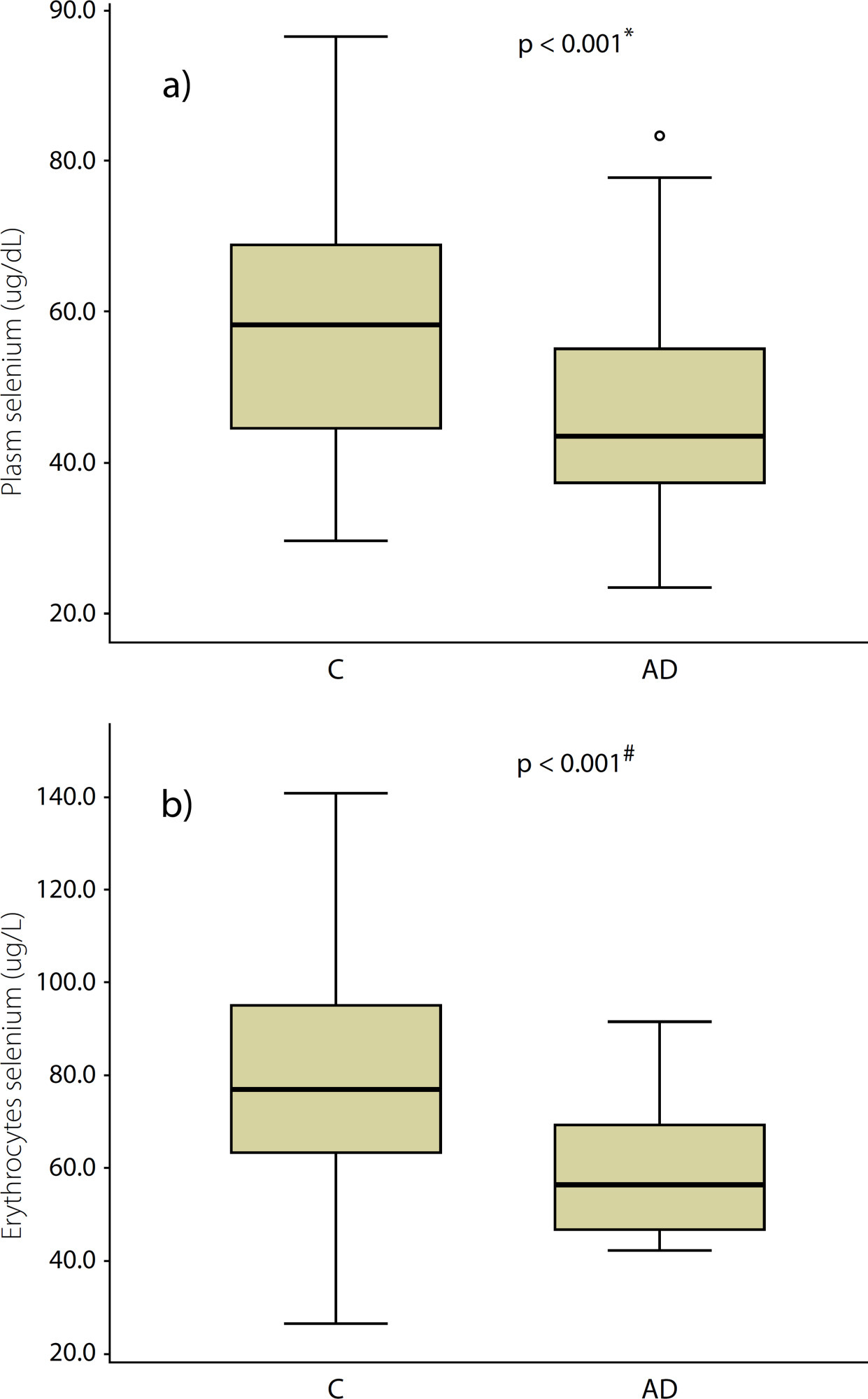
-
ARTÍCULO DE REVISIÓN05/07/2021
Nursing care related to fall prevention among hospitalized elderly people: an integrative review
Revista Brasileira de Enfermagem. 2021;74:e20200904
Resumen
ARTÍCULO DE REVISIÓNNursing care related to fall prevention among hospitalized elderly people: an integrative review
Revista Brasileira de Enfermagem. 2021;74:e20200904
DOI 10.1590/0034-7167-2020-0904
Visualizações0Ver maisABSTRACT
Objective:
to identify scientific productions on nursing care related to fall risk prevention among hospitalized elderly people.
Methods:
an integrative literature review from 2015 to 2019 in the PubMed/MEDLINE, Scopus, Web of Science, LILACS, BDENF, SciELO and CINAHL databases, in Portuguese, English and Spanish. The keywords were elderly, hospitalization, accidents due to falls, nursing care.
Results:
thirty-three publications were analyzed. The synthesis of the studies resulted in the categories: Clinical nursing assessments to prevent falls among hospitalized elderly people; Fall risk factors for elderly people; Fall risk prevention strategies for elderly people.
Final considerations:
it was found that the scientific knowledge produced on nursing care related to fall risk prevention for hospitalized elderly people evidences the clinical assessment, risk factors and strategies such as nursing care, contributing to foster self-care behavior and promotion security for elderly people.

-
05/07/2021
Educational technology for bathing/hygiene of elders at home: contributions to career knowledge
Revista Brasileira de Enfermagem. 2021;74:e20200890
Resumen
Educational technology for bathing/hygiene of elders at home: contributions to career knowledge
Revista Brasileira de Enfermagem. 2021;74:e20200890
DOI 10.1590/0034-7167-2020-0890
Visualizações0Ver maisABSTRACT
Objective:
to build and validate an educational booklet for bathing and hygiene of elders at home.
Methods:
a methodological study, developed through data collection in literature and situational diagnosis, booklet construction, material qualification through validation by expert judges (11 nurses) and target audience (30 caregivers). Data were analyzed descriptively. The minimum content validity index of 0.80 was considered.
Results:
in content and appearance validation, experts assigned Content Validity Index global of 0.92, while for assessment of the material’s suitability, the booklet was classified as “superior”, with an average of 90%. In the validation of caregivers, the overall Content Validity Index was 1.0.
Conclusion:
the booklet was successfully validated and can be considered in the context of health education and collaborate with an adequate and safe practice of bathing and hygiene of elders at home.
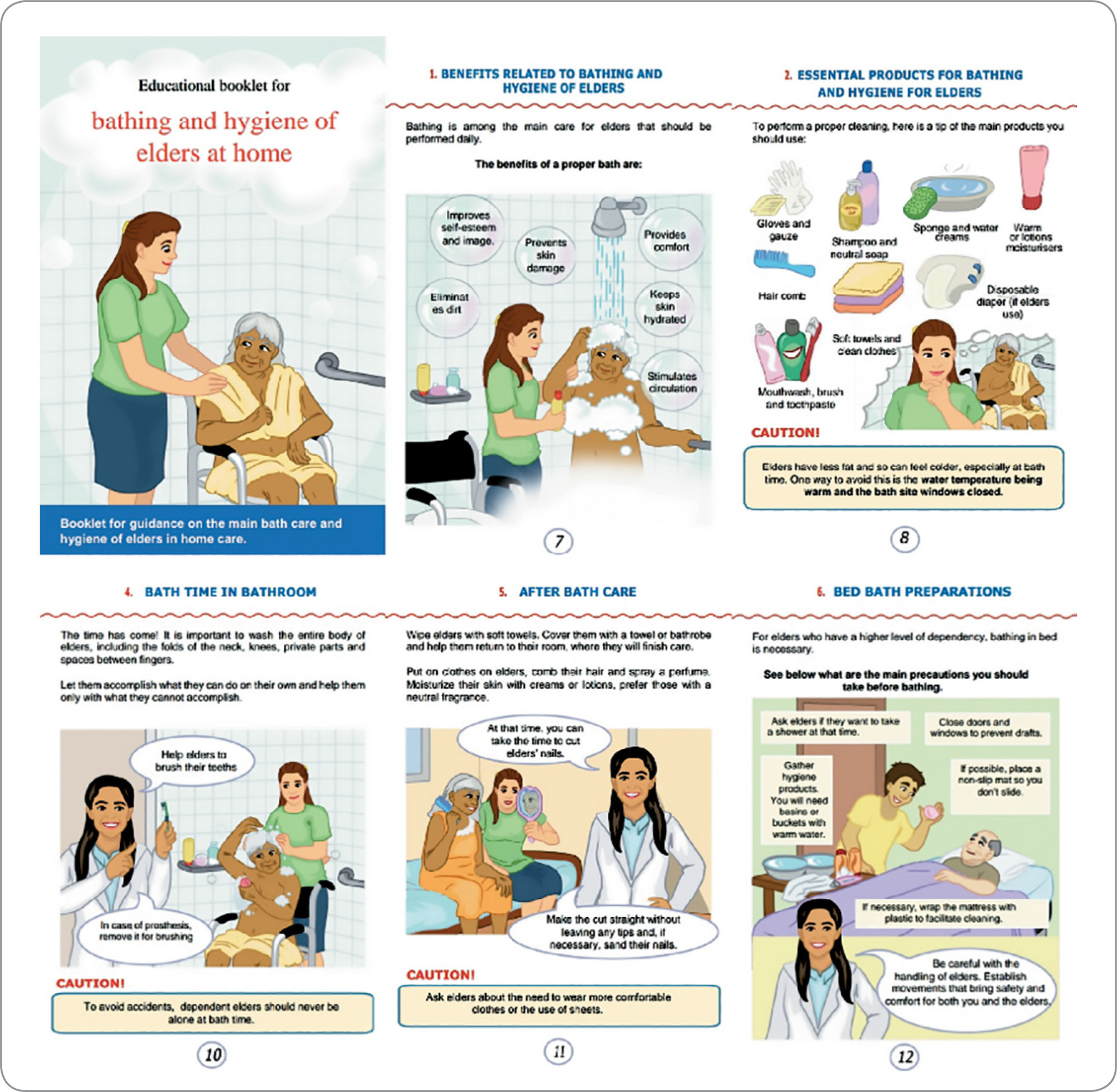
-
05/07/2021
Factors associated with urinary tract infection in a Nursing Home
Revista Brasileira de Enfermagem. 2021;74:e20200813
Resumen
Factors associated with urinary tract infection in a Nursing Home
Revista Brasileira de Enfermagem. 2021;74:e20200813
DOI 10.1590/0034-7167-2020-0813
Visualizações1Ver maisABSTRACT
Objective:
to analyze the factors associated with urinary tract infection occurrence in institutionalized elderly.
Methods:
this is a cross-sectional, analytical, quantitative study with 116 elderly people from a Nursing Home. Urinary tract infection diagnosis was carried out through urine culture and clinical assessment. Demographic data and associated factors were obtained from medical records. Statistical analysis included bivariate analysis and logistic regression models.
Results:
the factors associated with urinary tract infection (p<0.05) were being female; wheelchair user; diaper use; diuretic use; urinary and bowel incontinence; type 1 diabetes; benign prostatic hyperplasia; dehydration.
Conclusion:
this study revealed that it is important to consider non-modifiable factors such as sex and clinical comorbidities; however, dehydration, a modifiable factor, increased the chances of developing urinary tract infections by 40 times among institutionalized elderly and demands greater attention from the health team.
-
28/06/2021
Trends in fertility rates, proportion of antenatal consultations and caesarean sections among Brazilian adolescents
Revista Brasileira de Enfermagem. 2021;74:e20200884
Resumen
Trends in fertility rates, proportion of antenatal consultations and caesarean sections among Brazilian adolescents
Revista Brasileira de Enfermagem. 2021;74:e20200884
DOI 10.1590/0034-7167-2020-0884
Visualizações1Ver maisABSTRACT
Objective:
To analyze the temporal trends in the fertility rate, proportion of antenatal consultations and caesarean sections in Brazilian adolescents aged 15 to 19, between 2000 and 2015. Methods: The fertility rate, proportion of prenatal consultations and proportion of routes of birth were calculated using data from DATASUS. The trend analysis was performed using the Prais-Winsten regression model and the annual percentage change.
Results:
There was a trend of reduction of 3.5% per year in the fertility rate among adolescents (p<0.05), in addition to an increasing trend of 6% per year in the proportion of more than six antenatal consultations (p <0.0001) and an increasing trend of 6.8% per year in the proportion of caesarean sections (p<0.0001).
Conclusion:
Despite the decreasing trend in fertility rates among Brazilian adolescents, they remain high. Also noteworthy is the growing trend for caesarean sections, even with improved access to antenatal care.
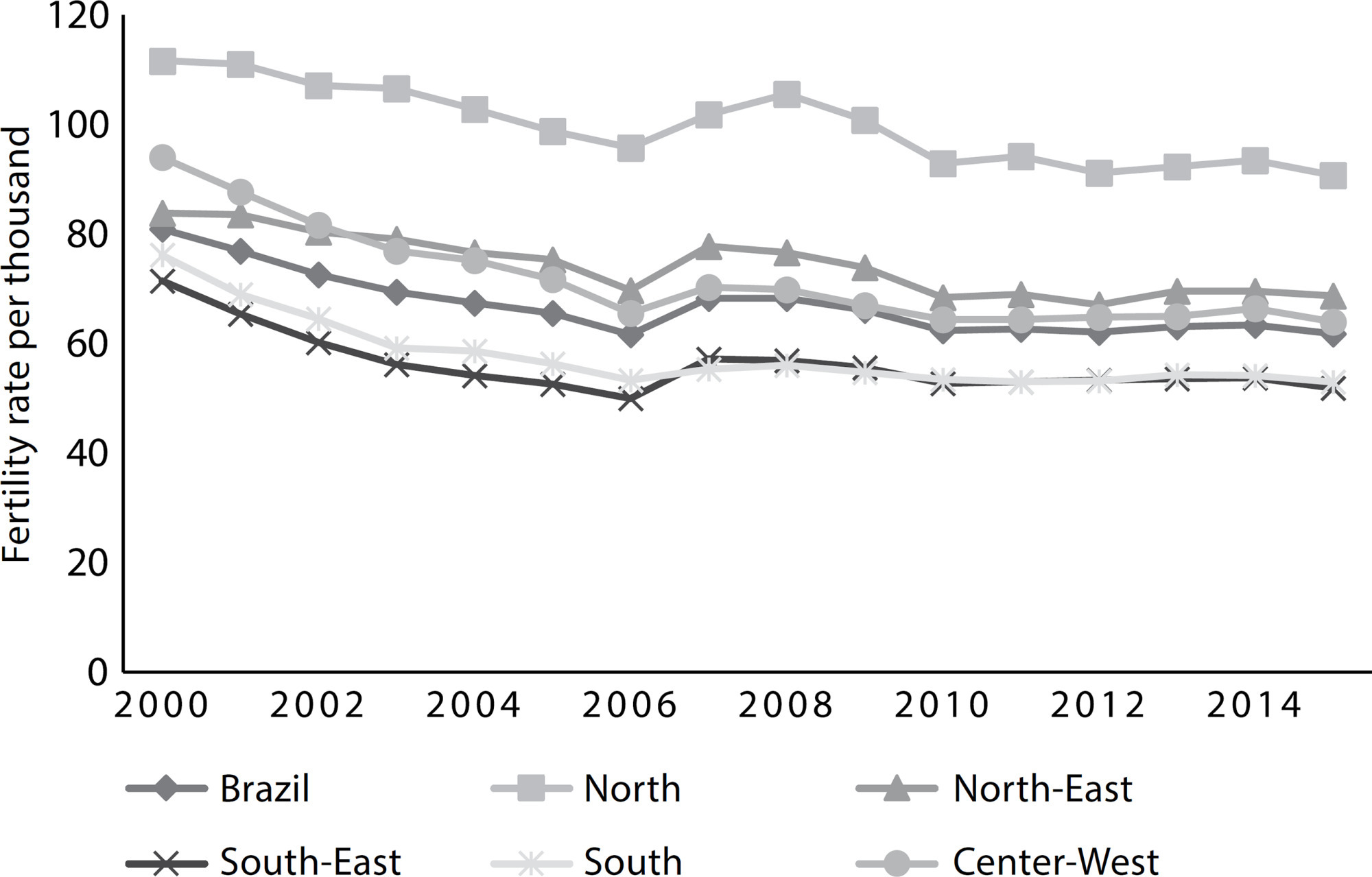
-
28/06/2021
Validation of an instrument for systematizing nursing care in pediatrics
Revista Brasileira de Enfermagem. 2021;74:e20200222
Resumen
Validation of an instrument for systematizing nursing care in pediatrics
Revista Brasileira de Enfermagem. 2021;74:e20200222
DOI 10.1590/0034-7167-2020-0222
Visualizações0Ver maisABSTRACT
Objective:
to verify the validity of indicators’ content referring to the instrument for data collection in children aged 0 to 5 years hospitalized in a pediatric clinic.
Method:
a cross-sectional methodological study was carried out with 11 experts between January and May 2018. For data collection, the steps for validating the instrument’s content were respected. For data analysis, Content Validity Index and Kappa agreement analysis were used.
Results:
after content analysis, a Content Validity Index of 0.94 and Kappa 0.71 was issued according to the experts’ suggestions 81.9%. Therefore, the instrument was suitable for applicability.
Conclusion:
the instrument proved to be valid in terms of content for pediatric care, contributing significantly to improving care for hospitalized children aged 0 to 5 years.
-
28/06/2021
Individual and contextual variables associated with smoking and alcohol consumption during pregnancy
Revista Brasileira de Enfermagem. 2021;74:e20200804
Resumen
Individual and contextual variables associated with smoking and alcohol consumption during pregnancy
Revista Brasileira de Enfermagem. 2021;74:e20200804
DOI 10.1590/0034-7167-2020-0804
Visualizações1Ver maisABSTRACT
Objective:
to analyze the association between individual characteristics and housing context with smoking and alcohol consumption during pregnancy.
Methods:
a cross-sectional study with a probabilistic sample of 3,580 pregnant women who underwent prenatal care in the Unified Health System in 2019. The outcomes were firsthand, secondhand smoke and alcohol consumption during pregnancy. Individual characteristics and the living environment were used as exploratory variables.
Results:
living in a neighborhood with episodes of violence, without social cohesion and without urban elements that encourage physical activity was associated with smoking. Alcohol consumption during pregnancy was associated with living in environments that do not encourage physical activity. Smoking was also associated with lower income and education.
Conclusions:
individual characteristics and the living environment are associated with smoking, secondhand smoke and alcohol consumption during pregnancy.
-
INFORME DE EXPERIENCIA01/01/2018
Clinical and epidemiological teaching of dengue through simulated practice
Revista Brasileira de Enfermagem. 2018;71(2):451-456
Resumen
INFORME DE EXPERIENCIAClinical and epidemiological teaching of dengue through simulated practice
Revista Brasileira de Enfermagem. 2018;71(2):451-456
DOI 10.1590/0034-7167-2016-0503
Visualizações2Ver maisABSTRACT
Objective:
to describe the experience of clinical teaching on dengue and the practice of epidemiological surveillance using problematization methodology.
Method:
report of experience on educational activity with undergraduate nursing students, held in March 2016, at a public university in the city of São Paulo, conceived in four stages: dialogic lecture, active search of Aedes aegypti, case study and simulation of nursing consultation to individuals with dengue.
Results:
The activity allowed to retrieve previous knowledge about the disease, respond to exercises that addressed different clinical situations and epidemiological surveillance, including in situ evaluation of possible mosquito outbreaks, and discuss the need to expand prevention and health of the individual and the community, the impact of the media in the dissemination of cases and the coping difficulties experienced in the different levels of attention.
Conclusion:
the methodology adopted enabled qualified training of students to cope with dengue.

-
ARTÍCULO ORIGINAL18/07/2022
Beliefs, knowledge, actions of nursing techniques in breastfeeding in pain management in immunization
Revista Brasileira de Enfermagem. 2022;75(6):e20210546
Resumen
ARTÍCULO ORIGINALBeliefs, knowledge, actions of nursing techniques in breastfeeding in pain management in immunization
Revista Brasileira de Enfermagem. 2022;75(6):e20210546
DOI 10.1590/0034-7167-2021-0546
Visualizações1Ver maisABSTRACT
Objective:
Understand the beliefs, knowledge, and actions of nursing technicians on breastfeeding as a form of non-pharmacological intervention to relieve pain in newborns and infants during immunization.
Methods:
Qualitative study carried out through semi-structured interviews with nine nursing technicians from three Basic Health Units in a city in the state of São Paulo. The theoretical approach of the Belief Model and the methodological framework of Thematic Analysis supported this study.
Results:
Three themes originated: Beliefs, Knowledge, and Actions of nursing technicians.
Final considerations:
Despite knowledge about the benefits of breastfeeding as the most effective method for relieving pain in newborns and infants during vaccination, their restrictive beliefs overrode the evidence, leading them to act in ways that discourage or prevent the mother from breastfeed during vaccination. Formal training is recommended to align with current evidence-based practices.
-
ARTÍCULO DE REVISIÓN08/12/2023
Educational technologies for accident prevention due to falls in childhood: a scoping review
Revista Brasileira de Enfermagem. 2023;76:e20220807
Resumen
ARTÍCULO DE REVISIÓNEducational technologies for accident prevention due to falls in childhood: a scoping review
Revista Brasileira de Enfermagem. 2023;76:e20220807
DOI 10.1590/0034-7167-2022-0807
Visualizações2Ver maisABSTRACT
Objectives:
to map evidence on educational technology use for accident prevention due to falls in childhood.
Methods:
a scoping review, carried out in October and November 2022, in the MEDLINE, Web of Science, BDENF and CINAHL databases and LILACS bibliographic index. There was no delimitation of language or time. Data were extracted and analyzed descriptively by two independent researchers. The research protocol was registered in the Open Science Framework.
Results:
twenty-six studies were selected. Booklets, pamphlets and leaflets were the most used technologies, presenting health services as the most frequent environment to develop research on fall prevention. The technologies developed were important outcomes: increased knowledge of children, family members, caregivers, health and education professionals.
Conclusions:
educational technology use makes it possible to increase knowledge, adopt safe practices and reduce falls.

-
ARTÍCULO DE REVISIÓN15/03/2024
Resources for health literacy among caregivers of prematurely born children: a scoping review
Revista Brasileira de Enfermagem. 2024;77(1):e20230062
Resumen
ARTÍCULO DE REVISIÓNResources for health literacy among caregivers of prematurely born children: a scoping review
Revista Brasileira de Enfermagem. 2024;77(1):e20230062
DOI 10.1590/0034-7167-2023-0062
Visualizações1Ver maisABSTRACT
Objectives:
to map the available evidence on resources used to promote health literacy among caregivers of prematurely born children during outpatient follow-up.
Methods:
the Joanna Briggs Institute’s scope review protocol was utilized. The search encompassed six databases, incorporating studies from 2012 to 2022.
Results:
the three included publications revealed that the resources employed are: mobile applications, phone calls, individual counseling, videos, educational pamphlets, and group discussions. Implementing an education protocol during the transition home enhances scientifically grounded health promotion rates.
Conclusions:
there is limited literature addressing the health literacy of these caregivers. The nursing team plays a crucial role in health education and in developing resources applicable to these families.

-
ARTÍCULO ORIGINAL13/01/2024
Social representations of oncologic surgery for patients with cancer
Revista Brasileira de Enfermagem. 2024;77(6):e20230273
Resumen
ARTÍCULO ORIGINALSocial representations of oncologic surgery for patients with cancer
Revista Brasileira de Enfermagem. 2024;77(6):e20230273
DOI 10.1590/0034-7167-2023-0273
Visualizações2Ver maisABSTRACT
Objectives:
to analyze the social representations of patients with cancer regarding oncologic surgery.
Methods:
a qualitative study based on Social Representation Theory was conducted with 126 participants between October 2021 and May 2022 in a public hospital in Rio de Janeiro. A characterization questionnaire, free evocations of the inducing term “surgery”, and semi-structured interviews with 60 participants were applied. Data were analyzed using Microsoft Excel® and IRaMuTeQ.
Results:
the central core of the representation is composed of fear, cure, hope, and removing the disease. The analysis of interviews resulted in six classes that highlight the social changes caused by treatment as well as the need for a support network to cope with the surgical process.
Final Considerations:
the representations reflect fear and hope towards the procedure and the desire to remove the disease, thus translating the cure through surgery.

-
ARTÍCULO ORIGINAL13/01/2024
Nurses’ perspectives on the use of telemonitoring in the management of people with diabetes and hypertension
Revista Brasileira de Enfermagem. 2024;77(6):e20230481
Resumen
ARTÍCULO ORIGINALNurses’ perspectives on the use of telemonitoring in the management of people with diabetes and hypertension
Revista Brasileira de Enfermagem. 2024;77(6):e20230481
DOI 10.1590/0034-7167-2023-0481
Visualizações3Ver maisABSTRACT
Objectives:
to understand the perspective of nurses on the use of telemonitoring in the management of people with type 2 diabetes mellitus and arterial hypertension in primary care.
Methods:
this qualitative research involved sixteen nurses from eight municipalities in Paraná. Data were collected between November 2022 and January 2023 through inperson or remote interviews, which were audio-recorded and subjected to content analysis.
Results:
according to the nurses, telemonitoring enhances users’ knowledge about these conditions, communication and connection with the team, and productivity. However, the lack of electronic resources and equipment, high staff turnover, low user adherence, and the limited availability of professional time present significant challenges.
Final Considerations:
the effective implementation and operation of telemonitoring in the management of people with diabetes and hypertension involve both potential benefits and barriers. It is essential to have the availability of human and technological resources, managerial support, and the commitment of professionals and users.
-
ERRATUM13/01/2024
ERRATUM
Revista Brasileira de Enfermagem. 2024;77(6):e2024n6e08
Resumen
ERRATUMERRATUM
Revista Brasileira de Enfermagem. 2024;77(6):e2024n6e08
DOI 10.1590/0034-7167.20247706e08
Visualizações2In the article “Brazilian nursing specific situation, middle and micro-range theories: a bibliometric study”, with DOI number: , published in Revista Brasileira de Enfermagem, 2024;77(4):e20230520, Chart 1:Where it read:[…]Ver mais -
ARTÍCULO ORIGINAL29/09/2022
Palliative care production for health professionals in the context of home care
Revista Brasileira de Enfermagem. 2022;75(1):e20210030
Resumen
ARTÍCULO ORIGINALPalliative care production for health professionals in the context of home care
Revista Brasileira de Enfermagem. 2022;75(1):e20210030
DOI 10.1590/0034-7167-2021-0030
Visualizações1Ver maisABSTRACT
Objectives:
to analyze palliative care production developed by health professionals to home care patients.
Methods:
this is an exploratory study, with a qualitative approach, using the transpersonal care theoretical framework. Thirteen interviews were conducted with health professionals and 18 observations were conducted on different cases. Content analysis was performed using MAXQDA©.
Results:
actions performed: maintenance and follow-up measures to people eligible for palliative care, in acts of dialogue and «listening» to caregivers and users, conducting guidelines for the care and self-care process, performing technical procedures, delivery of materials, referrals and medical prescriptions to users.
Final Considerations:
it is perceived the need for advances in the implementation of government policies in Brazil that insert palliative care into the Health Care Network through educational, managerial and care actions that ensure human dignity, thus allowing the development of these and other palliative care interventions.
-
ARTÍCULO ORIGINAL13/12/2019
Uso de tecnologia móvel para o cuidado gestacional: avaliação do aplicativo GestAção
Revista Brasileira de Enfermagem. 2019;72:266-273
Resumen
ARTÍCULO ORIGINALUso de tecnologia móvel para o cuidado gestacional: avaliação do aplicativo GestAção
Revista Brasileira de Enfermagem. 2019;72:266-273
DOI 10.1590/0034-7167-2018-0641
Visualizações0RESUMO
Objetivo:
avaliar o aplicativo GestAção, com base na experiência de uso das gestantes.
Método:
estudo de natureza avaliativa, aplicada, metodológica, com abordagem quanti-qualitativa. A ferramenta tecnológica foi avaliada por 13 gestantes por meio de questionários para a caracterização do perfil sociodemográfico e o uso da escala de Likert, para calcular o Índice de Validade de Conteúdo (IVC) do aplicativo; e entrevista semiestruturada, com análise fundamentada na Semiótica.
Resultados:
o estudo evidenciou significativo nível de satisfação das gestantes com o uso do aplicativo, considerando os objetivos (IVC= 0,92), estrutura e apresentação (IVC= 0,86), e relevância (IVC= 0,92).
Considerações finais:
o aplicativo GestAção obteve IVC geral de 0,90, evidenciando-o como tecnologia facilitadora e coadjuvante no empoderamento das gestantes interessadas em obter conhecimentos sobre o período gravídico, mostrando-se uma potente ferramenta para qualificar as boas práticas na consulta de enfermagem.
Palavras-chave: Aplicativos MóveisCuidados de EnfermagemGestaçãoPromoção da SaúdeTecnologia em SaúdeVer mais -
ARTÍCULO ORIGINAL17/02/2020
Estresse ocupacional em profissionais de enfermagem de um hospital universitário
Revista Brasileira de Enfermagem. 2020;73(2):e20180997
Resumen
ARTÍCULO ORIGINALEstresse ocupacional em profissionais de enfermagem de um hospital universitário
Revista Brasileira de Enfermagem. 2020;73(2):e20180997
DOI 10.1590/0034-7167-2018-0997
Visualizações0RESUMO
Objetivos:
Identificar a presença de estresse ocupacional nos profissionais de enfermagem de um hospital universitário do interior de Minas Gerais e analisar a influência das características sociodemográficas e ocupacionais neste agravo.
Métodos:
Estudo transversal, exploratório e quantitativo, realizado com 124 profissionais de enfermagem de um hospital universitário do interior de Minas Gerais. Para sua efetivação, foi utilizada a versão adaptada e validada para o português da escala Job Stress Scale (JSS).
Resultados:
A maioria dos profissionais era mulheres (87,9 %), com média de idade de 40,2 anos, 80,6 % eram técnicos de enfermagem e 71,8% da amostra apresentava algum grau de exposição ao estresse ocupacional.
Conclusões:
O índice de estresse ocupacional foi superior ao observado em estudos anteriores. Os dados obtidos no estudo apontam para a necessidade de implementar medidas institucionais de prevenção ao estresse ocupacional, sobretudo fortalecendo o apoio social no trabalho.
Palavras-chave: Equipe de EnfermagemEstresse OcupacionalHospital UniversitárioProfissionais de EnfermagemSaúde do TrabalhadorVer mais -
REFLEXIÓN01/07/2020
Como traduzir o conhecimento científico à prática? Conceitos, modelos e aplicação
Revista Brasileira de Enfermagem. 2020;73(5):e20190179
Resumen
REFLEXIÓNComo traduzir o conhecimento científico à prática? Conceitos, modelos e aplicação
Revista Brasileira de Enfermagem. 2020;73(5):e20190179
DOI 10.1590/0034-7167-2019-0179
Visualizações0RESUMO
Objetivos:
apresentar o conceito de Tradução e Intercâmbio do Conhecimento tal como vem sendo utilizado na literatura internacional e, em particular, no Canadá. A seguir, descrever um renomado modelo conceitual para orientar a sua implementação, intitulado Ciclo do Conhecimento à Ação.
Resultados:
ilustramos a utilização do modelo no contexto do sistema municipal de atenção básica à saúde no sul do Brasil, na implementação de estratégias de manejo da dor durante a vacinação.
Conclusões:
nesta reflexão teórica, argumentamos sobre a importância de se traduzir o conhecimento científico aos diversos contextos de prática e criar oportunidades de intercâmbio com os usuários desse saber, como profissionais de saúde, gestores, formuladores de políticas públicas, pacientes, familiares e demais grupos de interesse, para promover equidade e qualidade dos cuidados no Sistema Único de Saúde.
Palavras-chave: Competência ClínicaDifusãoDisseminação de InformaçãoTradução do ConhecimentoTranslaçãoVer mais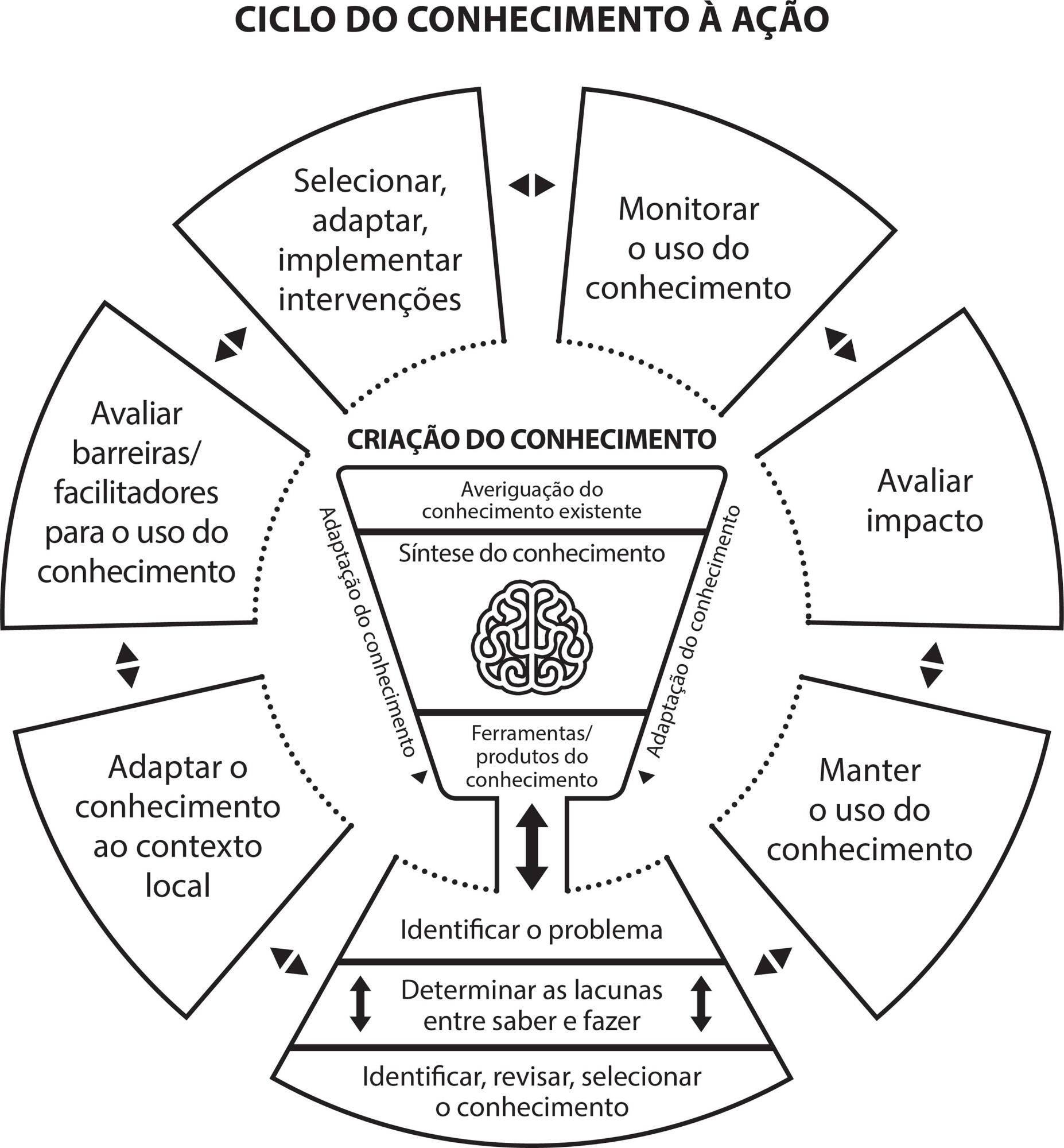
-
REFLEXIÓN05/03/2021
Trabalho do enfermeiro no contexto da pandemia de COVID-19
Revista Brasileira de Enfermagem. 2021;74:e20200594
Resumen
REFLEXIÓNTrabalho do enfermeiro no contexto da pandemia de COVID-19
Revista Brasileira de Enfermagem. 2021;74:e20200594
DOI 10.1590/0034-7167-2020-0594
Visualizações0Ver maisRESUMO
Objetivo:
Refletir sobre o trabalho experienciado pelo enfermeiro no enfrentamento da pandemia de COVID-19 vivenciado em um hospital público do estado do Rio Grande do Norte.
Métodos:
Ensaio reflexivo embasado na vivência profissional em um hospital público de referência para atendimento de pacientes acometidos pela COVID-19 no estado do Rio Grande do Norte. Os resultados foram organizados em duas categorias empíricas, que destacam as potencialidades e entraves do trabalho do enfermeiro diante da COVID-19, apresentados por meio do diagrama de Ishikawa.
Resultados:
Duas categorias emergiram das experiências vivenciadas: Protagonismo da enfermagem na organização dos serviços de saúde para o enfrentamento da COVID-19; e O exercício da gerência dos cuidados de enfermagem na pandemia de COVID-19.
Considerações finais:
Necessita-se valorizar o trabalho do enfermeiro em todos os seus atributos, bem como fortalecer os processos de trabalho interdisciplinares, que colaboram para a superação da crise ocasionada pela pandemia.
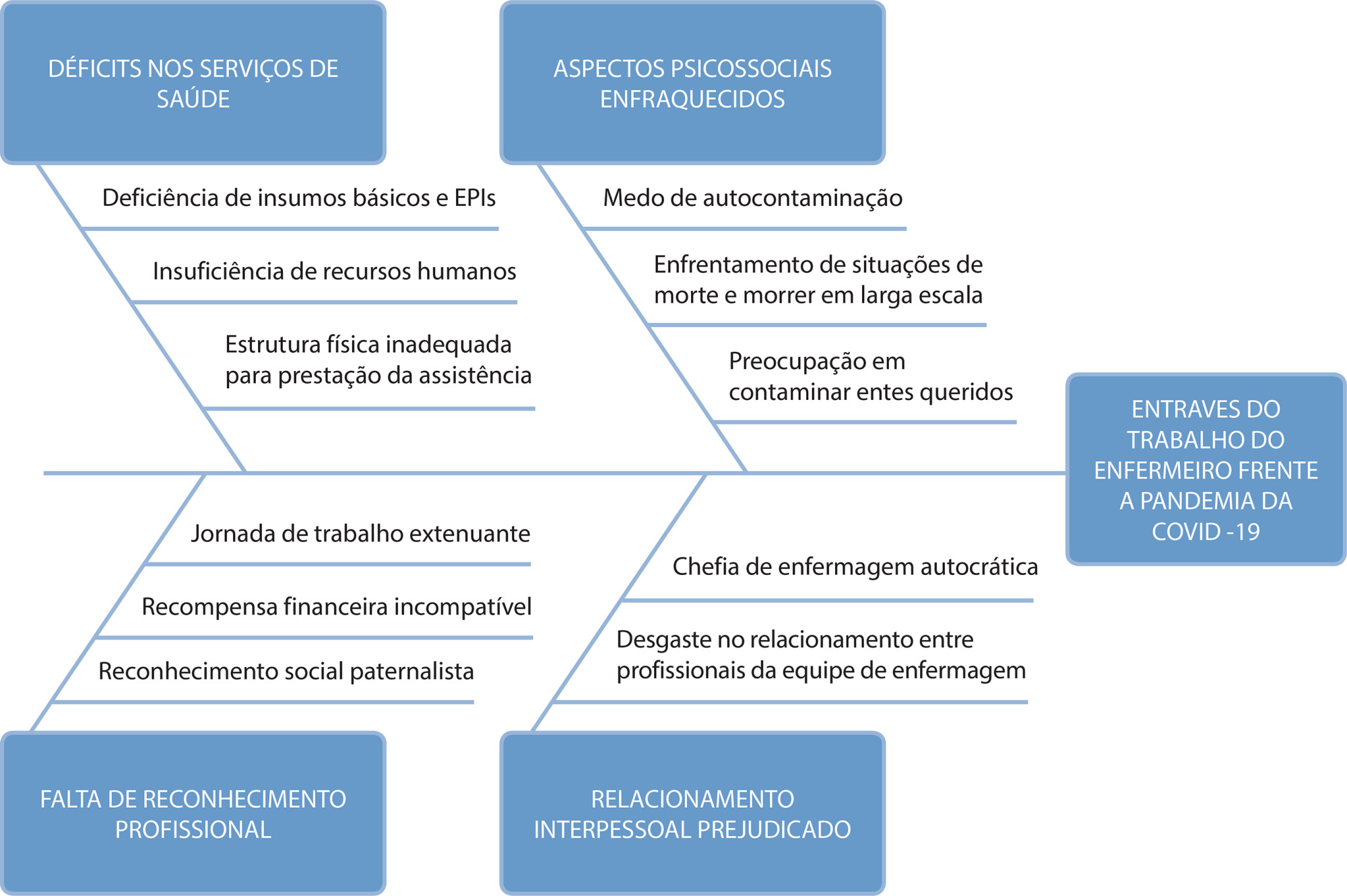
-
ARTÍCULO ORIGINAL08/07/2020
Construção e validação de protocolo assistencial de enfermagem com intervenções educativas para cuidadores familiares de idosos após Acidente Vascular Cerebral
Revista Brasileira de Enfermagem. 2020;73:e20180894
Resumen
ARTÍCULO ORIGINALConstrução e validação de protocolo assistencial de enfermagem com intervenções educativas para cuidadores familiares de idosos após Acidente Vascular Cerebral
Revista Brasileira de Enfermagem. 2020;73:e20180894
DOI 10.1590/0034-7167-2018-0894
Visualizações0Ver maisRESUMO
Objetivo:
construir e validar o conteúdo de um protocolo assistencial de enfermagem com intervenções educativas para cuidadores familiares de idosos após Acidente Vascular Cerebral.
Métodos:
estudo metodológico conduzido em três etapas: (1) construção do protocolo por meio de revisão da literatura; (2) pré-teste com equipe multiprofissional, analisado com articulação da literatura; (3) validação do protocolo pela Técnica Delphi.
Resultados:
o protocolo foi estruturado nos domínios: Orientações Sobre a Doença; Suporte Emocional; Utilização da Rede de Atenção à Saúde; Alimentação; Vias Aéreas; Medicações; Higiene; Cuidados com a Pele; Eliminações; Vestir/Despir; Posicionamento e Transferência; Prevenção de Quedas. No pré-teste, oito especialistas avaliaram a clareza e o conteúdo do protocolo. Na validação, houveram duas rodadas pela Técnica Delphi. O protocolo validado foi composto por 12 domínios contendo 42 itens e 240 orientações de cuidados.
Conclusão:
o protocolo qualifica a transição do cuidado após alta hospitalar auxiliando os enfermeiros na prática assistencial no domicílio.
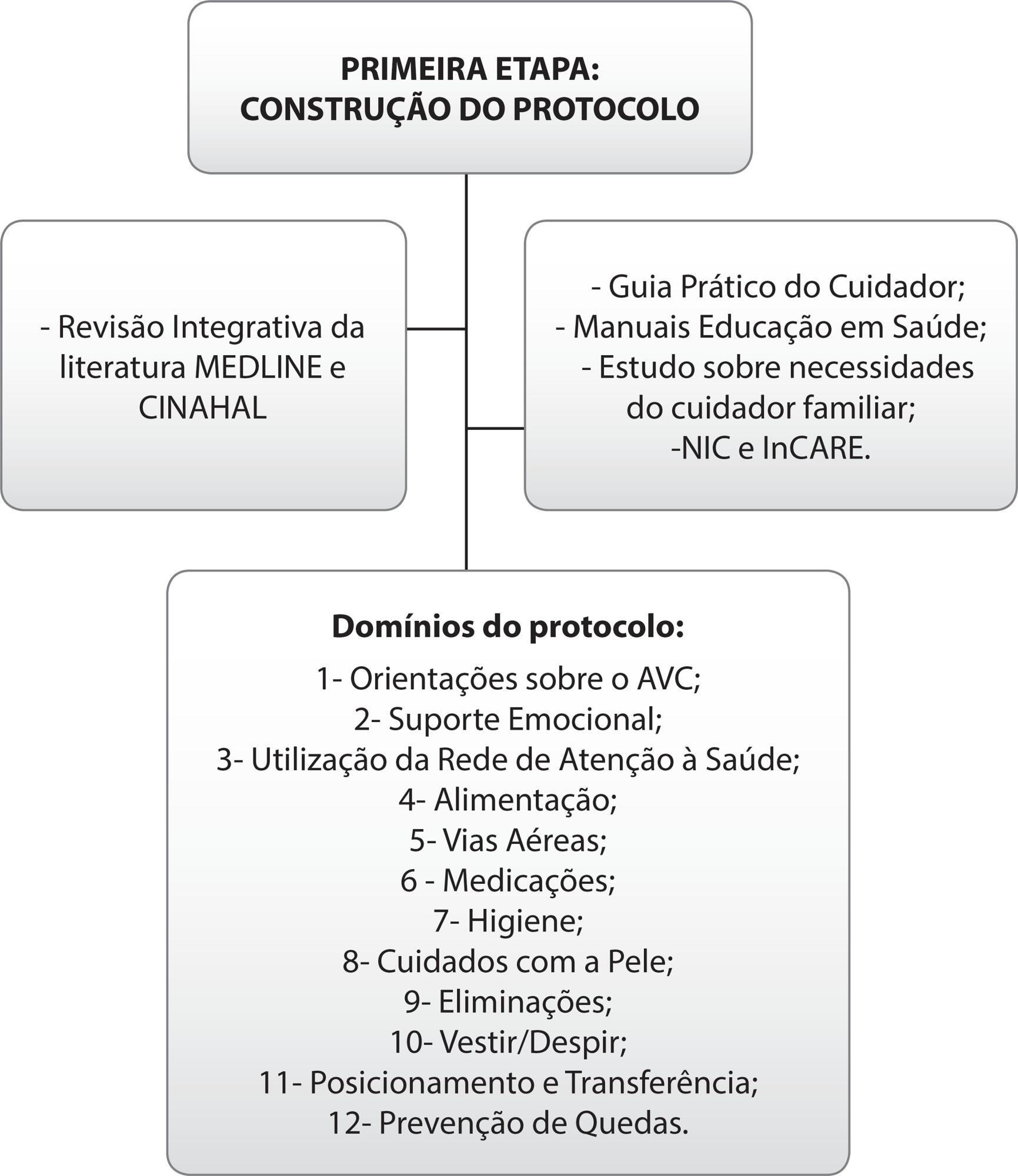
-
ARTÍCULO DE REVISIÓN22/04/2020
Polycyclic aromatic hydrocarbons and development of respiratory and cardiovascular diseases in workers
Revista Brasileira de Enfermagem. 2020;73(3):e20180965
Resumen
ARTÍCULO DE REVISIÓNPolycyclic aromatic hydrocarbons and development of respiratory and cardiovascular diseases in workers
Revista Brasileira de Enfermagem. 2020;73(3):e20180965
DOI 10.1590/0034-7167-2018-0965
Visualizações0Ver maisABSTRACT
Objectives:
to identify the scientific evidence on the development of cardiovascular and respiratory diseases due to workplace contamination by polycyclic aromatic hydrocarbons.
Methods:
integrative literature review. The search for primary articles was held in October 2017 in the Medical Literature Analysis and Retrieval System Online (through Pubmed), Web of Science and Latin American and Caribbean Literature in Health Sciences (LILACS).
Results:
the 16 studies analyzed showed that exposure to polycyclic aromatic hydrocarbons was associated with cardiovascular diseases, such as increased blood pressure, heart rate variation, and ischemic heart disease; and respiratory disorders, such as decreased lung function, chronic obstructive pulmonary disease, asthma, wheeze, coughing, pulmonary wheezing, chest tightness, effort dyspnea, and sore throat.
Conclusions:
polycyclic aromatic hydrocarbons cause deleterious effects on the cardiovascular and respiratory systems through mutations and cellular inflammation, being a risk to exposed individuals.
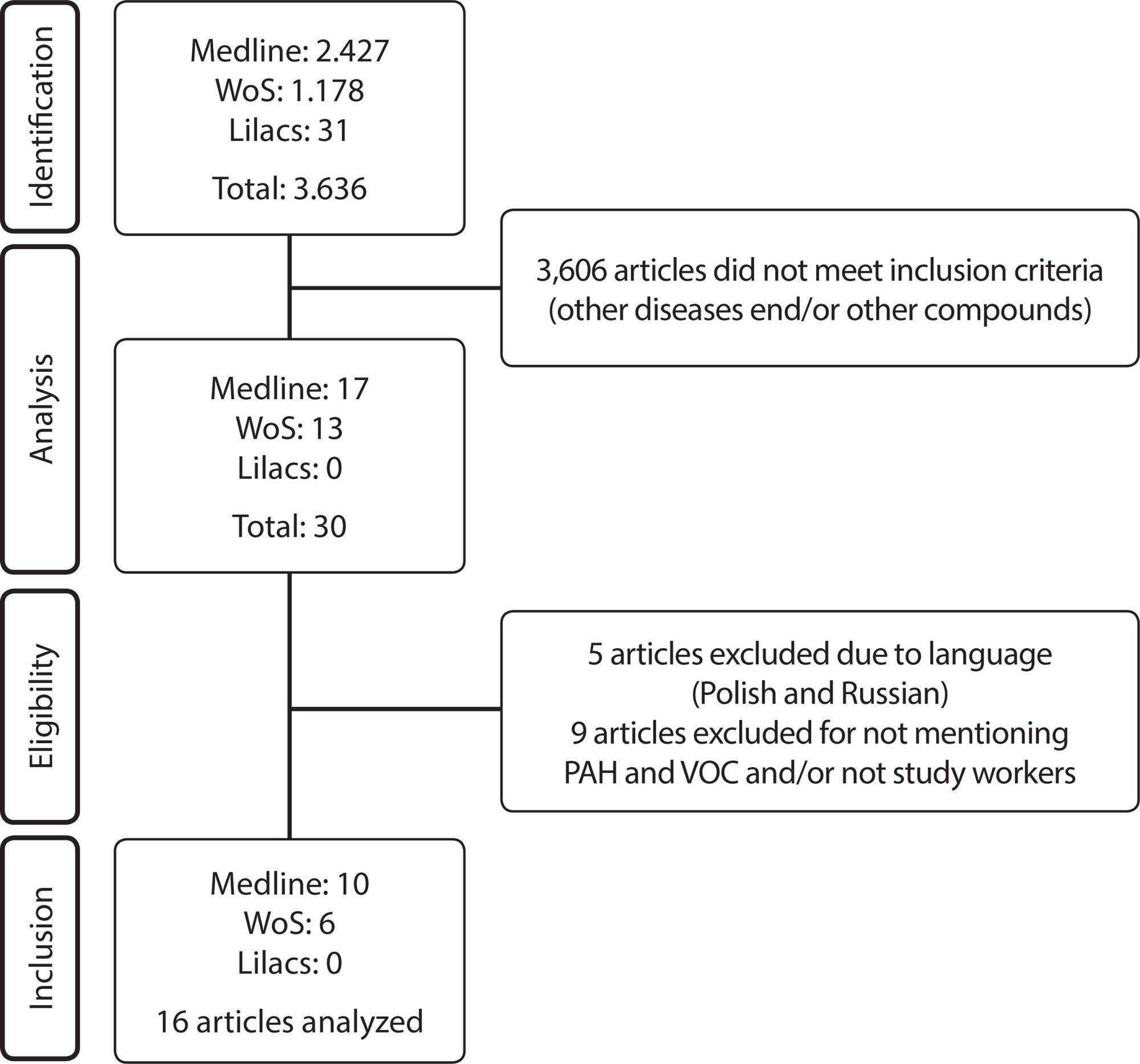
-
ARTÍCULO ORIGINAL23/10/2020
Building and validating an educational video for elderly individuals about fall risks
Revista Brasileira de Enfermagem. 2020;73:e20200010
Resumen
ARTÍCULO ORIGINALBuilding and validating an educational video for elderly individuals about fall risks
Revista Brasileira de Enfermagem. 2020;73:e20200010
DOI 10.1590/0034-7167-2020-0010
Visualizações0Ver maisABSTRACT
Objective:
to build and validate educational video for elderly individuals about fall risks.
Methods:
methodological study with video building. validated by 22 judges and assessed by 22 elderly individuals. Content was selected from the Fall Prevention Model and items from the Falls Risk Awareness Questionnaire. Items with an agreement greater than 0.80 were considered valid. verified through Content Validation Index (CVI) and binomial test.
Results:
building the video was guided by the Cognitive Theory of Multimedia Learning. Digital animation and audio narration were used. It lasted ten minutes and five seconds and included biological. socioeconomic. behavioral and environmental risks as well as precautions to avoid them. The CVI of judges had an average of 0.99. and of elderly individuals. an average of 1.0.
Conclusion:
the video was built and validated for content and understanding and can be used to prevent falls in elderly individuals.
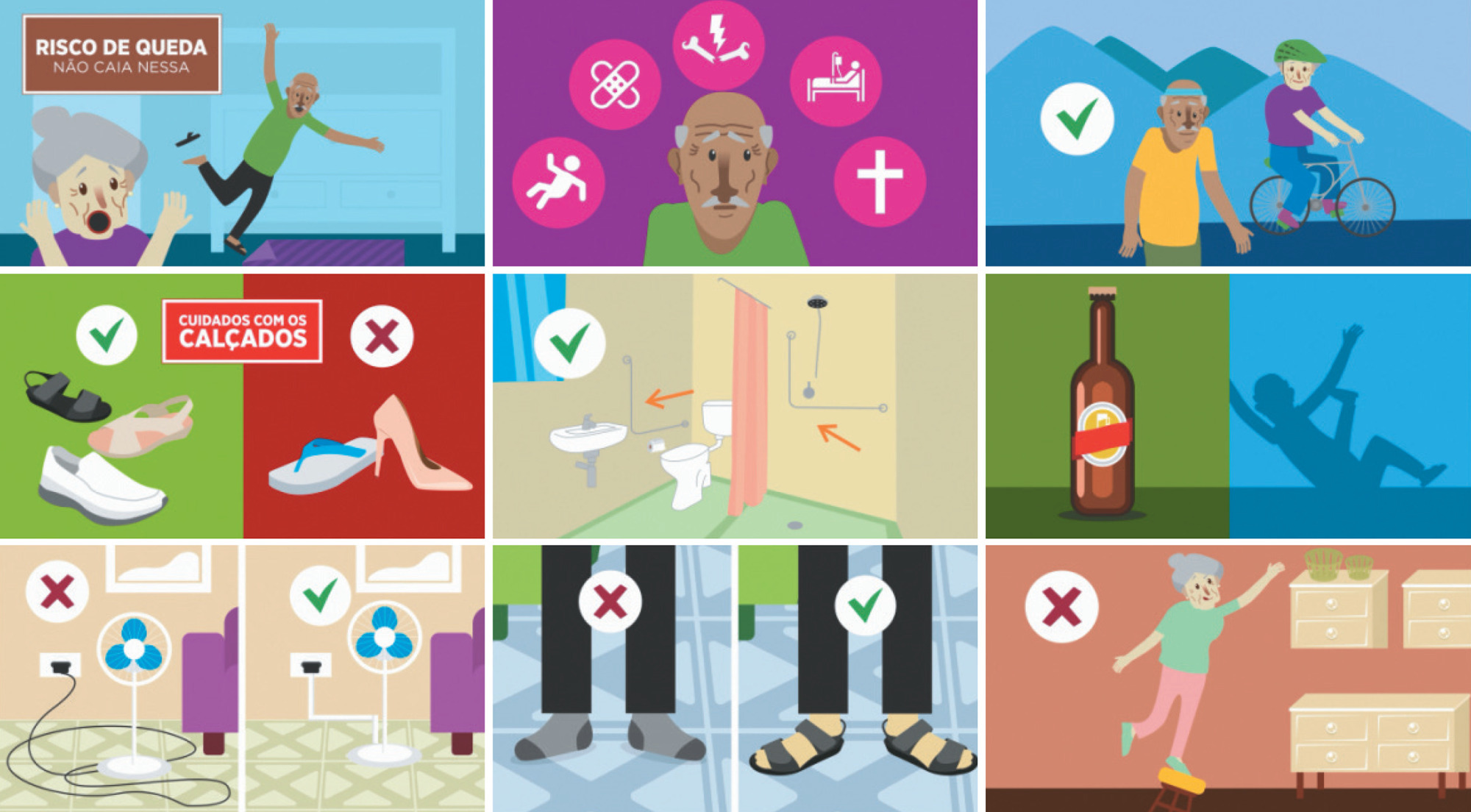
Búsqueda
Buscar en:
Nuvem de Tags
Adolescente (85) Atenção Primária à Saúde (239) COVID-19 (91) Criança (91) Cuidados de Enfermagem (269) Educação em Enfermagem (151) Educação em Saúde (139) Enfermagem (930) Enfermagem Pediátrica (86) Estudantes de Enfermagem (77) Estudos de Validação (131) Família (87) Idoso (208) Promoção da Saúde (99) Qualidade de Vida (104) Saúde do Trabalhador (86) Saúde Mental (145) Saúde Pública (82) Segurança do Paciente (150) Tecnologia Educacional (100)



